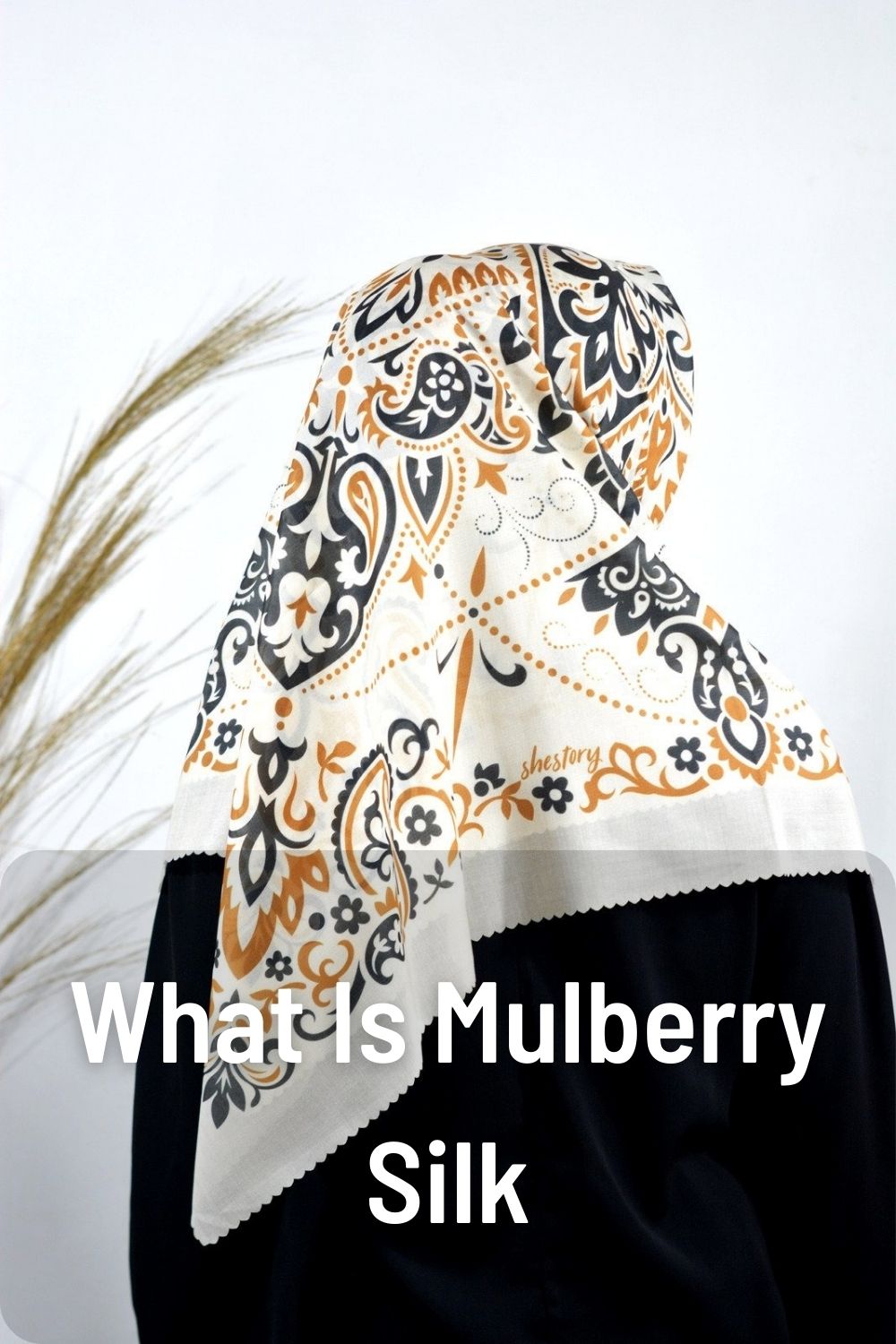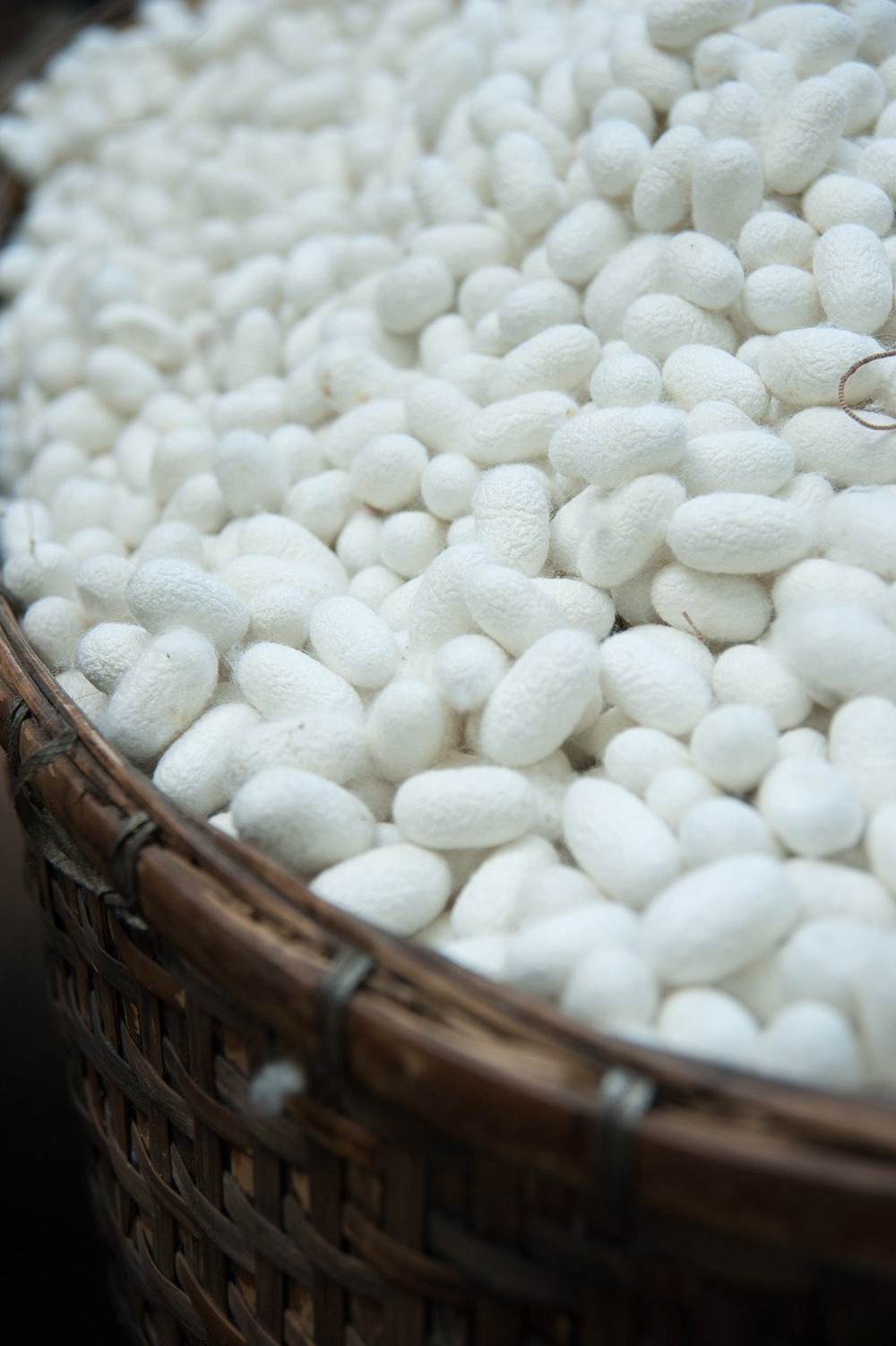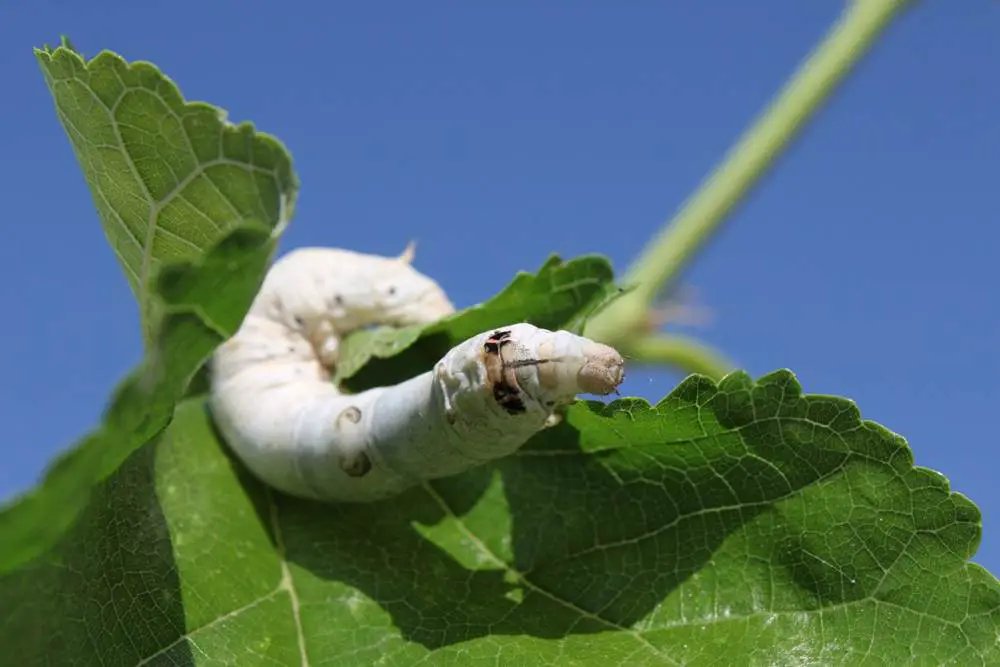
Silk is one of the most coveted and luxurious fabrics in the world. While there are many different types of silk, mulberry silk reigns supreme as the highest quality and most desirable silk on the market.
In this complete guide, we will cover everything you need to know about mulberry silk – from how it’s made, to its unique properties and characteristics, and why it’s so prized in high fashion and home decor. We’ll also provide tips on how to care for mulberry silk items to keep them looking their best. Let’s dive in!
Table of Contents
What is Mulberry Silk

Mulberry silk refers specifically to silk harvested from the silkworm of the mulberry plant, known as Bombyx mori. These silkworms feed exclusively on the leaves of mulberry trees, which is what gives their spun silk its famous white or off-white shimmering color.
Other types of silk come from different silkworm varieties that eat oak or ash tree leaves, producing rougher and less uniform fibers. But the Bombyx mori mulberry silkworm produces fine, long, and smooth strands that result in top-quality fabrics.
Key Facts About Mulberry Silk:
- Made from the cocoons of Bombyx mori silkworms
- Shimmering white or off-white color
- Very fine and smooth texture
- Lightweight and breathable
- Extremely soft to the touch
- Highly absorbent
- Strong and durable
- Drapes beautifully
- Dyes and prints very well
The highest grade of mulberry silk is produced in China, followed by India, Brazil, and Thailand as other top producers. But authentic mulberry silk can only come from the Bombyx mori silkworms feeding on the leaves of mulberry trees.
How is Mulberry Silk Made

Mulberry silk production is a remarkable process that starts with the metamorphosis of silkworm larvae into silk cocoons. Here’s an overview of the stages:
1. Silkworms Feed on Mulberry Leaves
Silk production starts with female silkworm moths laying hundreds of tiny eggs. The eggs hatch into larvae or caterpillars, which are fed fresh mulberry leaves around the clock. The silkworms literally eat their weight’s worth in mulberry leaves every day! These leaves are what provide the nutrients that allow the silkworms to spin fine, smooth silk strands.
2. Silkworms Spin Silk Cocoons
After gorging on mulberry leaves for about 35 days, the caterpillars are ready to spin their cocoons. The silkworm oozes a silk fiber from two glands on its head and constructs a cocoon around itself, winding the silk thread in a figure-8 motion.
The finished cocoon is made of a single continuous silk thread that is up to 3,600 feet long! This thread is so fine that it takes about 5,000 cocoons to make just one pound of raw silk.
3. Cocoons Are Harvested
Once the cocoons are completed, they are harvested after about one week, before the silkworms emerge as moths. Harvesting the cocoons prevents the silk fibers from breaking into short unusable pieces.
Cocoons are sorted and retained for silk reeling based on their quality, robustness, shape, and color. Any dark or discolored cocoons are discarded.
4. Silk Threads are Unwound from Cocoons
To unwind the long silk threads, the cocoons are placed in boiling water to loosen the natural glue (sericin) holding the strand together. Then the silk ends are found, combined together, and wound onto spools in a process known as silk reeling.
Up to 20 silk filaments can be combined together in the reeling process to create a single thicker thread. This helps maintain the continuous length of the silk fibers.
5. Raw Silk is Twisted into Yarn
The raw silk threads are twisted together into yarns of various thicknesses and strengths. This raw silk yarn is what weavers buy to produce silk fabrics and garments. The yarn can also be spun into different weights, from lace-weight to bulky, for knitting projects.
6. Finished Silk Fabrics are Produced
Silk yarns and threads are woven or knitted into finished fabrics through various methods:
- Broad fabrics like taffeta, charmeuse, duchess satin use plain or satin weaving techniques.
- Chiffon, crêpe, and georgette use twisted warp and weft yarns for a pebbled texture.
- Brocade, damask, and jacquard employ intricately woven designs and motifs.
- Lace silk uses fine yarns in lacy openwork patterns like with knitting.
- Velvets have a cut pile weave for a plush feel.
The endless weave variations let manufacturers create different weights, drapes, opacities, sheens, and textures to suit the final garment or furnishing design. From flowing chiffon to embroidered brocade, mulberry silk fabric provides unmatched elegance.
Properties and Characteristics of Mulberry Silk
Now that you understand how labor-intensive the production process is, let’s look at why mulberry silk is so coveted as a textile. What are the unique characteristics that make it a premium fabric choice
Extremely Smooth and Soft
The natural fibers of mulberry silk are very long and smooth. This gives a uniquely soft, fluid feel against the skin. Silk is one of the most hypoallergenic natural fabrics, meaning it rarely causes irritations or allergies. The softness also prevents wrinkling.
Lightweight and Breathable
Mulberry silk is a very lightweight fabric that is highly porous and breathable. It absorbs moisture well and allows heat to dissipate through the material. This makes silk garments and bedding ideal for both warm and cool climates.
Excellent Drape and Sheen
The smooth fibers refract light beautifully, giving mulberry silk its characteristic glossy appearance. Combined with the lightweight drape, this sheen allows silk clothing to elegantly skim over the body’s contours. Silk hangs, molds, pleats, and gathers exceptionally well.
Vibrant Dye Color
Silk fibers readily accept saturating dyes, unlike synthetics that dye only on the surface. As a protein fiber, silk absorbs dye chromogens similar to human hair, allowing vivid colorfast dying. Any hue can be achieved in silk with excellent depth, saturation, and permanence.
Strong and Resilient
Despite their delicacy, silk fibers are remarkably strong. Mulberry silk is stronger than steel filaments of the same diameter! Silk fabric is resistant to most mineral acids and can withstand repeated washing and wear while retaining its beauty.
Wrinkle and Moth Resistant
Pure mulberry silk resists wrinkles well, returning to its smooth appearance once hung. As a natural fiber, silk is somewhat prone to moths and carpet beetles, but not to the extent of wool. Proper storage can protect silk from insect damage.
Absorbs Moisture
The hydrophilic (water-loving) molecular structure of silk allows it to effectively absorb moisture up to 30% of its weight. This helps silk fabrics and garments maintain comfort and coolness next to skin.
Thermally Efficient
Silk adjusts to ambient temperatures well. It provides warmth during cool conditions by retaining heat next to skin. In warm conditions, the moisture wicking capacity helps silk fabrics feel up to 3°C cooler than other textiles. This adaptability makes silk ideal for any climate.
Hypoallergenic and Antibacterial
The smooth fibers of mulberry silk contain naturally occurring hygroscopic properties. This means silk repels mold, mildew, and dust mites and does not irritate sensitive skin. Silk fibers are inhospitable environments for bacteria as well.
Biodegradable and Sustainable
As a natural protein fiber, silk is completely biodegradable and recyclable. Silk production also requires far less water usage compared to cotton and synthetics. Choosing mulberry silk supports more eco-friendly textile production.
Uses of Mulberry Silk
With its unparalleled comfort, beauty, and versatility, mulberry silk has become ubiquitous as a luxury textile. Here are some of the most popular uses and products made from true mulberry silk:
Clothing
From haute couture fashion to ready-to-wear lines, mulberry silk is used extensively for all types of clothing:
- Dresses, gowns, blouses, lingerie
- Skirts, pants, linings
- Robes, caftans, lounge wear
- Ties, scarves, handkerchiefs
- Undergarments and slips
Virtually any garment can benefit from the fluidity and comfort of mulberry silk. It is also commonly used for linings and under layers.
Home Furnishings
Luxurious mulberry silk lends elegance to all bed and home textiles:
- Sheets, pillowcases, and duvet covers
- Blankets, quilts, and comforters
- Upholstery fabrics and curtains
- Cushions, shams, throws
- Table linens like tablecloths and napkins
The vibrant dye ability allows for incredible custom home décor in any color palette and design style.
Accessories
Mulberry silk is also ubiquitous in high-end fashion accessories:
- Ties, scarves, cravats, and handkerchiefs
- Gloves, alpettes, and outerwear linings
- Pocket squares, hair accessories, hats
- Bridal and formalwear accents
- Bag linings, pouches, and organizers
Silk adds luxury while also providing functionality like moisture-wicking for hair accessories.
How to Care for Mulberry Silk
While very durable, mulberry silk still requires proper care to maintain its pristine appearance over time. Here are some tips for keeping your silk items beautiful:
Hand Wash Separately
Never machine wash or dry clean silk! Always hand wash separately in cool or lukewarm water using a mild, pH-neutral soap or specialized silk wash. Avoid detergents with brighteners or bleach.
Rinse thoroughly with clean water to remove all residues which can yellow over time. Don’t wring or twist silk when wet. Roll in a towel to absorb excess moisture and lay flat to dry on a padded or draped surface.
Steam or Iron Inside Out
Steaming is ideal for removing wrinkles in silk clothing, drapes, and bedding. If ironing, use a cool setting and place a cloth between the silk and iron. Always iron inside out to avoid damaging the silk sheen.
Avoid Sunlight and Heat
Excess sun exposure will damage silk over time, causing it to yellow, weaken, and become brittle. Keep silk articles out of direct sunlight. For clothing, scarves, and upholstery, choose light colors that don’t absorb as much heat.
Watch for Snags and Pulls
Silk fibers are very strong but filaments can catch on rough surfaces and edges. Inspect seam allowances, hardware, embroidery, sequins, and beadwork regularly to check for snags. Address pulled threads immediately before major damage occurs.
Store Properly
Keep silk garments on padded hangers in breathable garment bags. Use stackable trunks or drawers for smaller silk accessories. Drape or roll larger home textiles to prevent creasing. Always store silk fabrics clean and dry.
Pre-Treat Stains
Many stains can set permanently on silk if not promptly pre-treated. Blot any spills quickly with a clean, absorbent cloth. For food, mud or grease, gently scrape off any solids first once the item has dried. Avoid vigorous rubbing which can damage the silk fibers.
Types of Mulberry Silk Fabrics
While all authentic silk comes from the mulberry silkworm, various production methods create different fabric types with unique properties. Here is an overview of the primary types of mulberry silk fabrics available:
Charmeuse Silk
Charmeuse silk has a satiny finish and reverse side with a lustrous front side. The charmeuse weave uses a satin technique with a plain or crepe back. It has a smooth, fluid drape that works beautifully for garments.
Chiffon Silk
Chiffon silk is made from very lightly twisted fine yarns for an almost translucent, airy silk fabric. It is lightweight and billowy with a soft drape and sheen. Silk chiffon is popular for blouses, lingerie, and evening gowns.
Crepe de Chine Silk
Crepe de chine silk has a slightly pebbled texture and a matte appearance. The crepe weave has highly twisted yarns alternating S and Z directions. Crepe de Chine drapes well and doesn’t easily wrinkle or fray, making it a popular dressmaking silk.
Fuji Silk
Fuji silk is a soft, lightweight plain-weave silk fabric like habotai but with a distinctive sheen. It works well for garments and homewares like pillowcases. Fuji silk drapes beautifully and resists wrinkles.
Habotai Silk
Habotai is a lightweight plain weave silk with a soft, smooth finish and subtle luster. Often used for linings, it works well for garments, upholstery, and accessories. Habotai silk is very affordable but prone to snags.
Organza Silk
Organza is a stiff, sheer plain weave silk fabric that holds its shape well. It has a crisp texture and often used for bridalwear and special occasion overlays. Silk organza can also add fullness to skirts and sleeves.
Raw Silk
Raw silk is the yarn or fabric in its unprocessed state after removing the sericin glue from cocoons. Raw silk is ivory/ebony in color with a coarse texture that softens through washing. It wrinkles easily but has a lovely sheen.
Satin Silk
Satin silk has a silky smooth, lustrous face and dull back. It has excellent drape and sheen due to the satin weave using warped or filling yarns brought to the fabric face. It makes for formal eveningwear and gowns.
Shantung Silk
Shantung silk has a rough, uneven texture like raw silk but with crispity. The nubby slubs come from cocoon fragments during reeling. It makes good casual garments and home décor accents with character.
Tussah Silk
Tussah silk is produced from wild silkworms instead of the cultivated Bombyx mori. It has a subtle uneven texture and deep coloration. Tussah is commonly used for menswear, décor, and embroidery accents.
Washable Silk
Washable silk is often habotai or crepe de Chine that’s been piece dyed then pre-washed. This preshrinking makes it machine washable in cool water. It’s a low maintenance silk for clothing, quilting, and crafts.
Wild Silk
Wild silk refers to silk made by silkworms other than the cultivated mulberry silkworm. It produces rougher, thicker yarns with different properties based on the silkworm variety. Wild silk examples include tussah, muga, and eri.
Identifying Genuine Mulberry Silk
With so many varieties and production methods, how can you identify real, authentic mulberry silk and avoid cheap imitations Here are some tips:
Check the Label
Look for a label that states it’s made from “100% silk.” Avoid blends – silk mixed with synthetics is not the coveted real deal. Reputable brands will denote mulberry or Bombyx mori silk specifically.
Review Fiber Details
Avoid generic terms like “natural fibers.” Quality silk items will list details like:
- Silk origin (Chinese, Indian, etc.)
- Silk type (charmeuse, dupioni)
- Metric thread count (19 momme, 12 momme)
- Metric yarn size (16/22 denier)
These specifics indicate a genuine silk textile.
Look for a Silk Stamp
Some brands stamp silk items with official certifications like the “Silk Mark” seal from Silk Mark Organization of India. This global standard verifies purity and quality standards were met.
Check Fabric Weight
Silk fabric should feel exceptionally lightweight and airy for its relative strength. Synthetic “silk-like” fabrics have more heft.
Test Fabric Sheen
Quality silk has an unmistakable refined sheen and smooth surface. Rub fabric together – it should make a soft swooshing sound. Synthetics sound more papery by comparison.
See How it Drapes
Drape a length of fabric over your hands – silk should conform fluidly with graceful, liquid drapes. It shouldn’t cling, stand away from the body, or hold stiff folds.
Do a Burn Test
Carefully ignite a snippet of fabric with a flame – silk fibers curl back from the heat versus melting like synthetics. Never do this test on clothing!
Conclusion
Mulberry silk reigns supreme as one of the world’s most luxurious, desirable textiles due to its unparalleled properties. From its smooth softness, vibrant dye absorption, moisture wicking abilities, and elegant drape, mulberry silk provides exceptional beauty and comfort for clothing, bedding, and décor.
Yet it takes an incredible amount of human effort to produce, from silkworm cultivation to cocoon harvesting and silk reeling. This labor-intensive process ensures the purity and quality of the fibers, making mulberry silk highly coveted by couture fashion designers and home furnishing artisans alike.
When cared for properly, mulberry silk items become heirloom pieces that last for generations. From evening gowns to bed sheets, mulberry silk provides a sensual enjoyment and refined aesthetic to anything it graces. Though it commands higher prices, genuine mulberry silk is an investment in life’s little luxuries that enhance everyday living.
Frequently Asked Questions
1. What makes mulberry silk so special?
Mulberry silk is prized for its incredibly smooth, soft texture. The long fibers refract light beautifully for a luminous sheen. It’s extremely lightweight and breathable, absorbing moisture away from the skin. The protein fibers take vivid saturated dyes in any hue. Mulberry silk also has natural hygroscopic properties, repelling dust mites, mold, and bacteria.
2. Is mulberry silk suitable for sensitive skin?
Yes, mulberry silk is naturally hypoallergenic so it rarely causes skin irritation or allergies. The smooth fibers don’t attract dust mites either. This makes mulberry silk ideal for sensitive skin.
3. How durable is mulberry silk?
Mulberry silk is remarkably durable and abrasion resistant considering how delicate it feels. With proper care, silk items can last for decades and become family heirlooms. Avoid harsh detergents, high heat, and sunlight to prevent weakening of fibers.
4. What’s the difference between mulberry silk and other silks?
Mulberry silk comes specifically from the cultivated Bombyx mori silkworm that eats white mulberry leaves. This produces the shimmering white fibers prized for top quality silk fabric. Other silkworm varieties produce inferior rough, uneven fiber.
5. How can I tell if something is made from real mulberry silk?
To identify real mulberry silk, look for a 100% silk label and details like thread count and fabric type. Silk should feel exceptionally lightweight and drape fluidly. Rubbing together produces a soft swooshing sound. Do a careful fabric burn test to check if it curls back without melting.